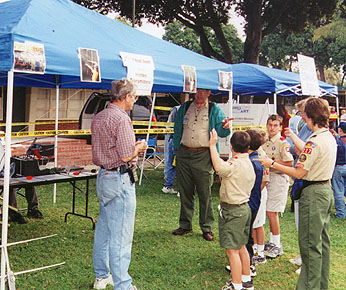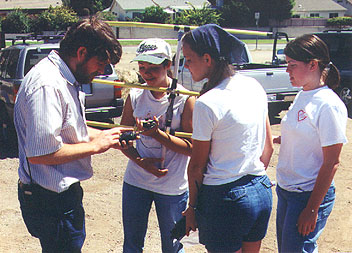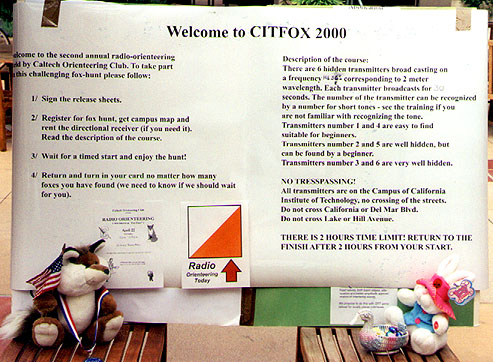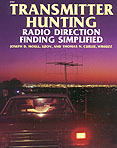

Tri-City Park ARDF on 10/28/00
ARDF Team USA got a big "Welcome Home" on October 28. David Corsiglia WA6TWF (upper left in the photos above) and the SuperSystem UHF repeater network put on a barbecue and potluck to fill everyone's tummy. There were hamburgers, hot dogs, and Korean BBQ ribs, plus lots of side dishes, desserts and the official ARDF Welcome Home cake.
Then it was time to exercise. A total of 15 transmitters (eleven on 2 meters, three on 70 centimeters and one on 80 meters) were on the air, awaiting the eager hunters. The UHF part of the hunt was primarily a demonstration. WA6TWF and John Luthy KF6QCQ led groups of would-be hunters to find the 70 cm foxes.
The 2-meter foxes were set up to provide two distinct hunts. The beginners 2m hunt had six ammunition-can transmitters on different frequencies, each on the air for about 7 seconds, then off for 30 seconds, then on again, and so forth. The goal was to find each one, punch your frequency sheet with the orienteering punch on it, then return. The team of Bob (KE6JI) and Ryan Millard did the best, finding five of them.
The advanced 2m hunt had an undisclosed number of micro-transmitters, all on 146.565 MHz, transmitting nearly continuously and QRMing each other. The challenge was to find all of them, write down the 3-digit code number on each, then return. One transmitter was in the rafters of a gazebo with its antenna in the clear, intended to jam the others. They were under the bleachers of the ball field, buried under some ivy, and so forth. Marvin Johnston KE6HTS (lower right in photos above) did the best on this hunt, finding them all in 52 minutes. Before the hunt, he had to make repairs to his antenna cable (bottom center in photos).
Several attendees tried out the 80-meter direction finding sets at the starting point, but only three went all the way to the 80m fox near the north end of the park. Young Jay W6JAY was the clear winner here, running to it and back in less than four minutes!
Joe Moell KØOV

Team USA members Marvin Johnston KE6HTS, Jay Thompson W6JAY and Richard Thompson WA6NOL (left to right) were honored at Tri-City Park on October 28, 2000.
JOTA Scout Demonstration on 10/21/00
Over 870 Scouts descended on Rancho Alamitos High School in Garden Grove for the annual Jamboree-On-The-Air (JOTA) on October 21, 2000. They participated in 13 ham radio exhibits, including HF, VHF, ARES, RACES, ATV, APRS/Packet, CW and hidden transmitter hunting. I put ten foxboxes on the school grounds, ranging from easy-to-spot ammunition cans in the bushes to a tiny micro-T taped on the pipes under a water fountain.
None of the Scouts had ever tried this activity before, so they all needed some quick training. Fortunately, there were some expert helpers, including Tom Curlee WB6UZZ (in the photo below), co-author of THRDFS. Also helping were 15-year-old Jay Thompson W6JAY and his father Richard WA6NOL. Both had just returned from the ARDF World Championships in China, where Jay competed in the Junior Division.
Scouts usually arrived at our foxhunting booth in groups of two or three, sometimes more. We found that a good way to start explaining RDF to them was to point out how it's used to find Emergency Locator Transmitters of downed aircraft. The techniques are similar to those used by biologists tracking radio-tagged animals in nature TV shows that most Scouts have seen.
After seeing how the RDF gear works, one Scout from the group was selected to track a transmitter as the others followed. The youthful hunter got continuous help and encouragement, of course. When he found it, another Scout was selected to find another ammo-can fox nearby. The last hunter of the group, who had received the benefit of watching all the others' mistakes, got to find a well-disguised micro-T for a surprise ending.
For more information about radio-orienteering for youth and Scouts, see Foxhunting for Scouts at this site.
Joe Moell KØOV

Huntington Beach ARDF on 10/5/00
Two dozen folks signed in at Huntington Central Park to enjoy an afternoon of on-foot radio direction finding fun. After checking their equipment by finding three two-meter practice transmitters near the starting point in the north end of the park, the hunters were started and timed individually as they sought the five main-event transmitters with IARU-standard timing.
This was the final practice for ARDF Team USA before the ARDF World Championships in Nanjing, China. Four of the 12 team members were present. (The rest live outside California.)
There were other experienced transmitter hunters there, including one pair from San Diego, plus some people that were trying it for the first time or just observing.
Here are results of the main two-meter event. Others hunted but didn't find any transmitters.
INDIVIDUALS Name & Callsign Div Foxes Time *Marvin Johnston KE6HTS OT 5 1:16:10 *Jay Thompson W6JAY JR 5 1:33:33 *Bob Cooley KF6VSE VT 5 1:57:11 Joe Loughlin KE6PHB ?? 5 1:57:15 Tony Boegeman WA6ZMZ VT 5 1:58:12 Scott Moore KF6IKO OT 3 2:07:47 David Corsiglia WA6TWF OT 2 1:27:27 Howard Brown KG6GI VT 2 2:45:20 Richard Thompson WA6NOL OT 1 1:02:02 TEAM Gary Holoubek VT 1 2:12:25 and Don Frizielle W6HRC * indicates Team USA members. WA6NOL is Team Trainer.
After finding all of the two meter foxes, two Team USA members found the 80-meter CW transmitter that was 3/4 of a kilometer away.
Jay Thompson W6JAY 0:12:02 Marvin Johnston KE6HTS 0:53:48
Although it's in an urban area, Huntington Central Park is an excellent foxhunting site because it is heavily vegetated with an abundance of great places to conceal foxboxes. There are many paved and unpaved trails, but route choice is very important. Direct "crow flies" distance to all foxes was 3.4 kilometers, but the shortest running route was about 4.5 km.
Joe Moell KØOV
Santa Barbara ARDF on 8/12/00
Results of event hosted by Marvin Johnston KE6HTS and members of the Santa Barbara Amateur Radio Club at Lake Los Carneros in Goleta.
Two meters (five foxes, 1-3/4 miles) Name Call Foxes Time Rick Barrett KE6DKF 5 0:43:27 Brian Peddicord KF6DZN 5 1:09:55 Bob Cooley KF6VSE 5 1:31:20 (Team USA) Scott Moore KF6IKO 5 1:52:55 Mike Peddicord KE6OTM 5 2:21:20 Jay Thompson W6JAY 4 1:29:44 (Team USA) Richard Thompson WA6NOL 3 1:08:52 (Team USA) Julia Vollmer 1 1:59:12 (First try!) Eighty meters (one fox, about a mile) Marvin Johnston KE6HTS 0:13:58 (Team USA) Rick Barrett KE6DKF 0:23:33 Brian Peddicord KF6DZN 0:33:20
Joe Moell KØOV

These two boys had great fun tracking radio foxes at Lake Los Carneros in March.
Wildwood Park ARDF on 7/15/00
Dean Dods KD6I and family of Thousand Oaks hosted an excellent ARDF session on July 15, 2000. Turnout was less than expected (only eight signed in), but everyone proclaimed it a success.
The section of Wildwood Park that Dean selected and mapped is similar to the Powder Canyon Wilderness of Schabarum Park, which was site of the team's 2m qualifying run in June. There's lots of elevation change (300 to 700 feet ASL range) and not much vegetation, except for the lowlands near the creek, which had some shade trees. That's where the finish line was. Pretty nice, except that it was a 1.4 km trek and 320-foot climb from there to the nearest parking lot.
Route choice was very important. MOI and MOE were on the mesa about 500 meters from and the same elevation as the start. The rest were in the canyon, about 300 feet lower. To have a good elapsed time, you had to find MO5 last, because it was very close to the finish. If you didn't, there was a lot of backtracking. Due to the hot weather, hiking up and down the canyon tended to slow hunters way down.
Results of hunters that found foxes: Name Foxes Time Rick Barrett KE6DKF 5 2:05:30 Marvin Johnston KE6HTS 5 2:25:00 Scott Moore KF6IKO 4 2:11:00 Brian Welch KF6TTV 2 2:42:50
Many thanks to Dean and his family for doing a great job of site selection, mapping, fox placement, and the many other details necessary for a successful ARDF event.
Joe Moell KØOV

July foxhunt organizer Dean Dods KD6I helped his daughters prepare their RDF gear before the hunt.
![]() Click for results of Team USA Qualifying Runs on 6/3/00 at Schabarum Regional Park and 6/4/00 at William R. Mason Park.
Click for results of Team USA Qualifying Runs on 6/3/00 at Schabarum Regional Park and 6/4/00 at William R. Mason Park.
Tri-City Park ARDF on 5/6/00
The Fullerton Radio Club's annual Antennas In The Park event was another great success this year. In addition to great food on the grill, including sample steaks and filets from a local meat distributor, there was the traditional National Foxhunting Weekend cake. And, as usual, there was an on-foot foxhunt so that everyone could work off their lunch.
After signing in and checking their direction finding equipment with the three practice transmitters nearby, twenty-five hams and non-hams took to the 60-acre course to track the six cycling foxes on 146.565 MHz. As evidence that southern California's on-foot hunters are improving their skills, most of them found them all.
Names Foxes Time Marvin Johnston KE6HTS 6 0:33:00 and Dale Schreihart KF6GON John Oppen KJ6HZ 6 0:37:05 and Julie Schleichner Jay Thompson W6JAY 6 0:38:55 Bob Dengler NO6B 6 0:41:00 Matthew Cook 6 0:42:00 Margaret Cerecedes KE6OAR 6 1:11:55 and family John Panner KD6CQR 6 1:21:50 Bob Legg W6QYY 6 1:41:30 and Phill Locke KD6LQO Shawn Ewald 6 1:55:50 and Maria Polletta Tracy Walter KF6RPX 6 2:03:00 and Steve Messerole N6ZSQ Paul Broden K6MHD 4 1:14:53 Dan Hanson KQ6YI 3 1:20:00 and Shelley Hanson KF6THN
The lone 80-meter transmitter got plenty of attention, too. Below are the results from participants who brought their own 80-meter RDF equipment. In addition, several others borrowed these sets to try this band. Bob W6QYY had just finished a rod-sense antenna system for his multi-mode scanner. John KD6CQR hunted with his scanner and whip antenna using the "hot-cold" method.
Jay Thompson W6JAY 7:42 Richard Thompson WA6NOL 10:31 Bob W6QYY and Phill KD6LQO 26:31 John Panner KD6CQR 34:46
Many thanks to the Fullerton (California) Radio Club for sponsoring this event. Additional thanks to April WA6OPS for providing the cake (best ever) and to Robert Rossi of Caltech for bringing extra RDF gear and helping pick up the transmitters afterwards.
Joe Moell KØOV

Caltech Campus ARDF (CITFOX) on 4/22/00
Pleasant weather and a site with lots of deceptive signal reflections combined to create an enjoyable but challenging foxhunt on the Caltech campus in Pasadena on April 22, 2000. Many newcomers tried on-foot RDF for the first time and were pleased by their success. Our goal was to have two of the six 2-meter fox transmitters be easy to find, two very difficult, and two in between. In addition, there was an optional hidden transmitter on 80 meters. It was across the campus, next to a building on California Boulevard, with the inverted-L antenna wire going up into two nearby trees.
A total of 22 persons tried the sport, 17 of them were first-timers. Seven found all six two-meter fox transmitters. Caltech orienteer Vadym Kapinus was overall winner, finding them in a blazing 54 minutes. ARDF Team USA member Marvin Johnston KE6HTS took second place (77 minutes), which was very good considering that he's a couple of decades older and was not familiar with the campus. Junior Division Team USA member Jay Thompson W6JAY took 5th place with 105 minutes. Other licensed hams on the hunt included Mark Seigel AD6KP, Ken Clardy N6EN, Paul Gordon N6LL, Travis Wood KG6AUR, Walter Collins KE6RCB and Ron Hudson KF6GKU.
After finding the 2-meter foxes, several persons tracked the 80-meter transmitter with borrowed equipment. Reported 80m scores included the team of KE6HTS and W6JAY (27 minutes) and Richard Thompson WA6NOL (35 minutes).
Many thanks to Leo Eisner, Rob Rossi, Shawn Ewald and Vadym Kapinus of the Caltech Orienteering Club for making this event possible.
Joe Moell KØOV
Mile Square Park ARDF on 3/25/00
Hazy sunshine and a cool ocean breeze made for ideal walking and running conditions at Mile Square Park in Fountain Valley, where the third southern California radio-orienteering (international-style foxhunting) event of 2000 took place on Saturday, March 25. Twenty-six hams and non-hams signed in and took to the course, which was medium-sized (190 acres), but had very little elevation change. (No, it's not a full square mile, because 70% of the site is taken up by golf courses, recreation center, nature area, archery range, etc.)
The most direct route from start to the five foxes and back to the finish was 2.5 miles (4 kilometers).
Rather than try to make the sometimes-difficult distinction between "beginners" and "experienced" hunters, I'm simply listing all the individuals together and all the teams together, in order of score. The individual listings include a two-letter code for the age division in which these persons would compete in an IARU championship. Juniors (JR) are age 18 and under, Seniors (SR) are 19 through 39, Old Timers (OT) are 40 through 54 and Veterans (VT) are 55 and up. Also listed are the number of fox transmitters found (5 maximum) and elapsed time. "USA" denotes an Team USA candidate.
INDIVIDUALS Jay Thompson W6JAY JR 5 0:48:35 USA Marvin Johnston KE6HTS OT 5 1:00:51 USA Gary Holoubek WB6GCT VT 5 1:12:33 Phil Dolber W6WBT OT 5 1:13:15 Brian Welch KF6TTV JR 5 1:31:13 Art Jury KF7GD SR 5 2:14:00 Dan Welch W6DFW VT 5 2:35:24 Richard Thompson WA6NOL OT 4 1:40:35 USA Travis Wood SR 2 2:43:00 TEAMS Tony Boegeman WA6ZMZ and Perri Matthews WB6SSP 5 0:58:30 Dick Bruno N6ISY and Bob Dengler NO6B 5 1:08:00 Phil Goodman KC6SEP and Karen Gerharter KG6USN 5 1:51:20 Tracy Walter KF6RPX and Richard Clark N6UZS 5 2:01:55 Cerecedes family (includes KE6OAQ & KE6OAR) 4 1:43:35 Scott and Hayley (age 8) Dickson 4 1:47:30 Allan AB8AA and Jane K8JAA Avnet 2 1:13:35
In addition to the two-meter foxes, there was a demonstration fox transmitter on 80 meters (3579 KHz), successfully found by Marvin KE6HTS. IARU ARDF championships always have separate hunts on two meters and 80 meters, but this is the first-ever southern California ARDF event to include 80m.
A special welcome to some hunters that drove long distances for their first Orange County ARDF event: WB6SSP and WA6ZMZ came from the El Cajon area, near San Diego. W6WBT and KF7GD are from the Lancaster vicinity.
Joe Moell KØOV

Despite carrying some extra weight, Art Jury did quite well at Mile Square Park ARDF. Is that his navigator back there?
Hillcrest Park ARDF on 2/19/00
A break between Pacific storms provided a perfect day for the first southern California international-style foxhunt of 2000. Twenty-seven persons signed in at this event, held at Hillcrest Park in Fullerton, California. I know that there were a few more, because some young family members were not listed.
There were the usual six two-meter FM foxboxes cycling at 30-second intervals and a couple of warm-up two-meter foxes for early arrivers. In addition, David Corsiglia WA6TWF of the SuperSystem provided two bonus transmitters on the 70 cm band.
Five potential members of Team USA for the World Championships in China used this event as a training session. Anyone who wished to be individually timed was given this opportunity before the rest of the participants started en masse. Six took advantage of this opportunity. There was no time limit.
Here are the results of the experienced individual runners and Team USA members. Only the six cycling 2mFM foxes are included in these scores:
Name(s) Foxes Time Marvin Johnston KE6HTS 6 0:36:56 Jay Thompson W6JAY (age 14) 6 1:10:10 Randy Lafferty KE6DOP 6 1:30:18 Gray Marshall KQ6MW 6 1:33:54 Kevin Kelly N6QAB 6 1:58:10 Brian Peddicord KF6DZN (age 13) 5 0:49:47 Richard Thompson WA6NOL 3 0:51:53
Here are scores of other participants, both individuals and families, most of whom were first-timers. They are not all-inclusive, because some chose to not turn in their cards.
Name(s) Foxes Time D Corsiglia WA6TWF & T Paquette N6OT 6 1:31:30 Scott Dickson 6 1:32:00 Tracy Walter KF6RPX (age 13) 6 2:06:45 Drew (age 7) and Sherry KE6EHX Lafferty 6 2:10:10 Brendan Lafferty (age 11) 6 3:01:40 David (age 12) & Ira WB6ZXA Feldman 4 1:16:40 Leonard Jensen KA6KZZ 4 1:38:45 Ian Bowlen & family 4 2:25:00 David Reeves AC6PP 4 2:49:40 Melissa (age 12) & Cindy KC6OPI Hughes 3 1:22:00 Leo Lake KF6ZLJ 2 2:07:40 Jeff Malnick KF6ZLP 2 2:38:20 Nick Peterson KF6JYW 2 2:44:58
It was great to see so many experienced ARDFers and others helping the newcomers to get their gear working and to learn the rudiments of radio-orienteering.
Joe Moell KØOV
![]() October 3, 1999 -- Hamcon/Foxhunt-99 at ARRL Southwestern Division Convention near Los Angeles
October 3, 1999 -- Hamcon/Foxhunt-99 at ARRL Southwestern Division Convention near Los Angeles
![]() August 9-12, 1999 -- IARU Region 2 ARDF Championships in Portland, Oregon with southern California participants
August 9-12, 1999 -- IARU Region 2 ARDF Championships in Portland, Oregon with southern California participants
![]() August 1, 1999 -- Training Event for IARU R2 Championships in Rowland Heights, California
August 1, 1999 -- Training Event for IARU R2 Championships in Rowland Heights, California
![]() May 8, 1999 -- Antennas In The Park in Placentia, California
May 8, 1999 -- Antennas In The Park in Placentia, California
 Go to International-Style Foxhunting Comes To The Americas -- How we're getting the ball rolling
Go to International-Style Foxhunting Comes To The Americas -- How we're getting the ball rolling
Go to Equipment Ideas for Radio-Orienteering -- Simple and inexpensive receiving and transmitting solutions
Go to Foxhunting for Scouts -- Let's get the kids involved
Go to Extenders Aid Handicapped Foxhunters -- A novel way to include persons with disabilities
Go to Local ARDF Contacts -- Links to hams and groups that are doing international-style foxhunting in North America and around the world.
 Back to the Homing In home page
Back to the Homing In home page
This page updated 19 March 2001